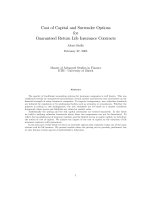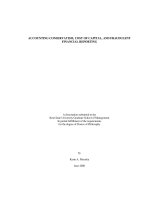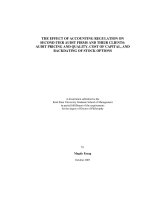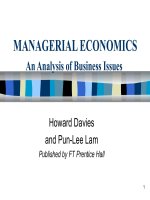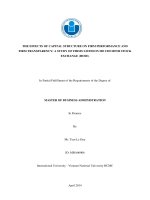27.Cost of Capital and Capital Structure Decision
Bạn đang xem bản rút gọn của tài liệu. Xem và tải ngay bản đầy đủ của tài liệu tại đây (117.95 KB, 15 trang )
CHAPTER 27
COST OF CAPITAL AND CAPITAL
STRUCTURE DECISIONS
The cost of capital is defined as the rate of return that is
necessary to maintain the market value of the firm (or price
of the firm’s stock).CFOs must know the cost of capital (the
minimum required rate of return) in (1) making capital
budgeting decisions, (2) helping to establish the optimal
capital structure, and (3) making decisions such as leasing,
bond refunding, and working capital management. The
cost of capital is used either as a discount rate under the
NPV method or as a hurdle rate under the IRR method.
The cost of capital is computed as a weighted average
of the various capital components, which are items on
the right-hand side of the balance sheet such as debt,
preferred stock, common stock, and retained earnings.
How do you compute individual costs
of capital?
Each element of capital has a component cost that is
identified by:
k
i
= before-tax cost of debt
k
d
= k
i
(1 − t) = after-tax cost of debt, where
t = tax rate
k
p
= cost of preferred stock
k
s
= cost of retained earnings (or internal equity)
k
e
= cost of external equity, or cost of issuing new
common stock
k
o
= firm’s overall cost of capital, or a weighted
average cost of capital
COST OF DEBT
The before-tax cost of debt can be found by determining
the internal rate of return (or yield to maturity) on the
bond cash flows.
515
516 Cost of Capital a nd Capital Structure Decisions
However, the following shortcut formula may be used
for approximating the yield to maturity on a bond:
k
i
=
I + (M − V)/n
(M + V)/2
where
I = annual interest payments in dollars
M = par or face value, usually $1,000 per bond
V = market value or net proceeds from the sale of a bond
n = term of the bond n years
Since the interest payments are tax-deductible, the cost
of debt must be stated on an after-tax basis. The after-tax
cost of debt is:
k
d
= k
i
(1 − t)
where t is the tax rate.
EXAMPLE 27.1
Assume that the Carter Company issues a $1,000, 8
percent, 20-year bond whose net proceeds are $940.
The tax rate is 40 percent. Then, the before-tax cost of
debt, k
i
,is:
k
i
=
I + (M − V)/n
(M + V)/2
=
$80 + ($1,000 − $940)/20
($1,000 + $940)/2
=
$83
$970
= 8.56%
Therefore, the after-tax cost of debt is:
k
d
= k
i
(1 − t) = 8.56%(1 − 0.4) = 5.14%
COST OF PREFERRED STOCK
The cost of preferred stock, k
p
, is found by dividing the
annual preferred stock dividend,
d
p
, by the net proceeds
from the sale of the preferred stock,
p, as follows.
k
p
=
d
p
p
Since preferred stock dividends are not a tax-deductible
expense, these dividends are paid after taxes. Conse-
quently, no tax adjustment is required.
Cost of Equity Capital 517
EXAMPLE 27.2
Suppose that the Carter Company has preferred stock
that pays a $13 dividend per share and sells for $100
per share in the market. The flotation (or underwrit-
ing) cost is 3 percent, or $3 per share. Then the cost of
preferred stock is:
k
p
=
d
p
P
=
$13
$97
= 13.4%
COST OF EQUITY CAPITAL
The cost of common stock, k
e
, is generally viewed as
the rate of return investors require on a firm’s common
stock. Two techniques for measuring the cost of common
stock equity capital are widely used: (1) t he Gordon’s
growth model and (2) the capital asset pricing model (CAPM)
approach.
The Gordon’s growth model is:
P
o
=
D
1
r − g
where
P
o
= value (or market price) of common stock
D
1
= dividend to be received in one year
r =investor’s required rate of return
g = rate of growth (assumed to be constant over time)
Solving the model for
r results in the formula for the
cost of common stock:
r =
D
1
P
o
+ g or k
e
=
D
1
P
o
+ g
Note that the symbol r is changed to k
e
to show that it
is used for the computation of cost of capital.
EXAMPLE 27.3
Assume that the market price of the Carter Company’s
stock is $40. The dividend to be paid at the end of the
coming year is $4 per share and is expected to grow
at a constant annual rate of 6 percent. Then the cost of
this common stock is:
518 Cost of Capital a nd Capital Structure Decisions
EXAMPLE 27.3 (continued)
k
e
=
D
1
P
o
+ g =
$4
$40
+ 6% = 16%
The cost of new common stock, or external equity
capital, is higher than the cost of existing common
stock because of the flotation costs involved in selling
the new common stock. Flotation costs, sometimes
called issuance costs, are the total costs of issuing and
selling a security that include printing and engraving,
legal fees, and accounting fees.
If
f is flotation cost in percent, the formula for the
cost of new common stock is:
k
e
=
D
1
P
o
(1 − f)
+ g
EXAMPLE 27.4
Assume the same data as in Example 27.3, except the
firm is trying to sell new issues of stock A and its
flotation cost is 10 percent Then:
k
e
=
D
1
P
o
(1 − f)
+ g =
$4
$40(1 −0.1)
+ 6% =
$4
$36
+ 6%
= 11. 11% + 6% = 17.11%
CAPITAL ASSET PRICING MODEL (CAPM)APPROACH
An alternative approach to measuring the cost of common
stock is to use the CAPM, which involves these four steps:
1. Estimate the risk-free rate,
r
f
, generally taken to be
the United States Treasury bill rate.
2. Estimate the stock’s beta coefficient,
b,whichis
an index of systematic (or nondiversifiable market)
risk.
3. Estimate the rate of return on the market portfolio,
r
m
,
such as the Standard & Poor’s 500 Stock Composite
Index or Dow Jones 30 Industrials.
4. Estimate the required rate of return on the firm’s
stock, using the CAPM equation:
k
e
= r
f
+ b(r
m
− r
f
)
Again, note that the symbol r
j
is changed to k
e
.
Cost of Retained Earnings 519
EXAMPLE 27.5
Assuming that r
f
is 7 percent, b is 1.5, and r
m
is 13
percent, then:
k
e
= r
f
+ b(r
m
− r
f
) = 7% + 1.5 (13% − 7%) = 16%
This 16 percent cost of common stock canbe viewed
as consisting of a 7 percent risk-free rate plus a 9
percent risk premium, which reflects t hat the firm’s
stock price is 1.5 times more volatile than the market
portfolio to the factors affecting nondiversifiable, or
systematic risk.
COST OF RETAINED EARNINGS
The cost of retained earnings, k
s
is closely related to the
cost of existing common stock, since the cost of equity
obtained by retained e arnings is the same as the rate
of return investors require on the firm’s common stock.
Therefore,
k
e
= k
s
How is the overall cost of capital
determined?
The firm’s overall cost of capital is the weighted average
of the individual capital costs, with the weights being the
proportions of each type of capital used. Let
k
o
be the
overall cost of capital.
k
o
=
(percentage of the total capital structure
supplied by each source of capital × cost of
capital for each source)
=
w
d
k
d
+ w
p
k
p
+ w
e
k
e
+ w
s
k
s
where
w
d
= % of total capital supplied by debts
w
p
= % of total capital supplied by preferred stock
w
e
= % of total capital supplied by external equity
w
s
= % of total capital supplied b y retained e arnings
(or internal equity)
The weights can be historical, target, or marginal.
520 Cost of Capital a nd Capital Structure Decisions
HISTORICAL WEIGHTS
Historical weights are based on a firm’s existing
capital structure. The use of these weights is based on
the assumption that the firm’s existing capital structure is
optimal and therefore should be maintained in the future.
Two types of historical weights can be used: book value
weights and market value weights.
Book Value Weights
The use of book value weights in calculating the firm’s
weighted cost of capital assumes that new financing will
be raised employing the same method the firm used for its
present capital structure. The weights are determined by
dividing the book value of each capital component by t he
sum o f the book values of all the long-term capital sources.
The computation of overall cost of capital is illustrated in
Example 27.6.
EXAMPLE 27.6
Assume the follo wing capital structure and cost of
each source of financing for the Carter Company:
Source Cost
Mortgage bonds
($1,000 par) $20,000,000 5.14% (Example 27.1)
Preferred stock ($100 par) 5,000,000 13.40% (Example 27.2)
Common stock ($40 par) 20,000,000 17.11% (Example 27.3)
Retained earnings
5,000,000 16.00% (Example 27.4)
$50,000,000
The book value weights and the overall cost of
capital are computed as:
Source Book value Weights Cost Weighted
cost
Debt $20,000,000 40%
a
5.14% 2.06%
b
Preferred
stock 5,000,000 10 13.40% 1.34
Common
stock 20,000,000 40 17.11% 6.84
Retained
earnings
5,000,000 10 16.00% 1.60
$50,000,000 100% 11.84
Overall cost of capital
= k
o
= 11.84%
a
$20,000,000/$50,000,000 = 0.40 = 40%
b
5.14% × 40% = 2.06%
Historical Weights 521
Market Value Weights
Market value weights are determined by dividing the
market value of each source by the sum of the market val-
ues of all sources. The use of market value weights forcom-
puting a firm’s weighted average cost of capital is theoret-
ically more appealing than the use of book value weights
because the market values of the securities closely approx-
imate the actual dollars to be received from their sale.
EXAMPLE 27.7
In addition to the data from Example 27.6, assume
that the security market prices are:
Mortgage bonds = $1,100 per bond
Preferred stock = $90 per share
Common stock = $80 per share
The firm’s number of securities in each category is:
Mortgage bonds =
$20,000,000
$1,000
= 20,000
Preferred stock =
$5,000,000
$100
= 50,000
Common stock =
$20,000,000
$40
= 500,000
Therefore, the market value weights are:
Source Number of Price Market
Securities Value
Debt 20,000 $1,100 $22,000,000
Preferred stock 50,000 $ 90 4,500,000
Common stock 500,000 $ 80
40,000,000
$66,500,000
The $40 million common stock value must be split
in the ratio of 4 to 1 (the $20 million common stock
versus the $5 million retained earnings in the origi-
nal capital structure), since the market value of the
retained earnings has been impounded into the com-
mon stock.
The firm’s cost of capital is:
Source Market Value Weights Cost Weighted
Average
Debt $22,000,000 33.08% 5.14% 1.70%
Preferred
stock 4,500,000 6.77 13.40% 0.91
522 Cost of Capital a nd Capital Structure Decisions
EXAMPLE 27.7 (continued)
Source Market Value Weights Cost Weighted
Common
stock 32,000,000 48.12 17.11% 8.23
Retained
earnings
8,000,000 12.03 16.00% 1.92
$66,500,000 100.00% 12.76%
Overall cost of capital = k
o
= 12.76%
TARGET WEIGHTS
If the firm has a target capital structure (desired debt-
equity mix) that is maintained over the long term, then
that capital structure and associated weights can be used
in calculating the firm’s weighted cost of capital.
MARGINAL WEIGHTS
Marginal weights involves use of the actual financial mix
used in financing the proposed investments. In using tar-
get weights, the firm is concerned with what it believes
to be the optimal capital structure o r target percentage.
In using marginal weights, the firm is concerned with
the actual dollar amounts of each type of financing to
be needed for a given investment project. This approach,
though attractive, presents a problem. The cost of cap-
ital for the individual sources depends on the firm’s
financial risk, which is affected by the firm’s financial
mix. If the company alters its present capital structure,
the individual costs will change, which makes it more
difficult to compute the weighted cost of capital. The
important assumption needed is that the firm’s financial
mix is relatively stable and that these weights will closely
approximate future financing practice.
EXAMPLE 27.8
The Carter Company is considering raising $8 million
for plant expansion. The CFO estimates using the
following mix for financing this project:
Debt $4,000,000 50%
Common stock 2,000,000 25%
Retained earnings
2,000,000 25%
$8,000,000 100%
EBIT-EPS Approach to Capital Structure Decisions 523
EXAMPLE 27.8 (continued)
The company’s cost of capital is computed as:
Source Marginal Cost Weighted
Weights Cost
Debt 50% 5.14% 2.57%
Common stock 25 17.11% 4.28
Retained earnings
25 16.00% 4.00
100% 10.85%
Overall cost of capital = k
o
= 10.85%
How do you determine the firm’s
optimal capital structure?
The concepts to be covered in this chapter relate closely
to the cost of capital and also to the crucial problem
of determining the firm’s optimal capital structure. We
will cover three methods that show how to build an
appropriate financing mix.
EBIT-EPS APPROACH TO CAPITAL
STRUCTURE DECISIONS
This analysis is a practical tool that enables the CFO to
evaluate alternative financing plans by investigating their
effect on EPS over a range of EBIT levels. Its primary
objective is to determine the EBIT breakeven, or indif-
ference, points between the various alternative financing
plans. The indifference point identifies the EBIT level at
which the EPS will be the same regardless of the financing
plan chosen by the CFO.
This indifference point has major implications for cap-
ital structure decisions. At EBIT amounts in excess of the
EBIT indifference level, the more heavily levered financing
plan will generate a higher EPS. At EBIT amounts below
the EBIT indifference level, the financing plan involving
less leverage will generate a higher EPS. Therefore, it is of
critical importance for the CFO to know the EBIT indif-
ference level. The indifference points between any two
methods of financing can be determined by solving for
EBIT in this equality:
(EBIT − I)(1 − t) − PD
S
1
=
(EBIT − I)(1 − t) − PD
S
2
where
t = tax rate
PD = preferred stock dividends
524 Cost of Capital a nd Capital Structure Decisions
S
1
and S
2
= number of shares of common stock
outstanding after financing for plan 1
and plan 2, respectively
EXAMPLE 27.9
Assume that ABC Company, with long-term capital-
ization consisting entirely of $5 million in stock, wants
to raise $2 million for the acquisition of special equip-
ment by (1) selling 40,000 shares of common stock at
$50 each, (2) selling bonds at 10 percent interest, or (3)
issuing preferred stock with an 8 percent dividend.
The present EBIT is $800,000, the income tax rate is 50
percent, and 100,000 shares of common stock are now
outstanding. To compute the indifference points, we
begin by calculating EPS at a projected EBIT level of
$1 million.
All All Debt All
Common Preferred
EBIT $1,000,000 $1,000,000 $1,000,000
Interest
200,000
Earnings before
taxes (EBT) $1,000,000 $ 800,000 $1,000,000
Taxes
500,000 400,000 500,000
Earnings after
taxes (EAT) $ 500,000 $ 400,000 $ 500,000
Preferred stock
dividend
160,000
Earnings
available to
common
stockholders $ 500,000 $ 400,000 $ 340,000
Number of
shares
140,000 100,000 100,000
EPS $3.57 $4.00 $3.40
Now connect the EPSs at the level of EBIT of $1
million with the EBITs for each financing alternative
on the horizontal axis to obtain the EPS-EBIT graphs.
We plot the EBIT necessary to cover all fixed financial
costs for each financing alternative on the horizontal
axis. For the common stock plan, there are no fixed
costs, so the intercept on the horizontal axis is zero.
For the debt plan, there must be an EBIT of $200,000
to cover interest charges. For the preferred stock plan,
there must be an EBIT of $320,000 [$160,000/(1 – 0.5)]
to cover $160,000 in preferred stock dividends at a
50 percent income tax rate; thus, $320,000 becomes
the horizontal axis intercept. (See Exhibit 27.1.) In this
example, the indifference point between all common
and all debt is:
EBIT-EPS Approach to Capital Structure Decisions 525
EXAMPLE 27.9 (continued)
(EBIT − I)(1 − t) − PD
S
1
=
(EBIT − I)(1 − t) − PD
S
2
(EBIT − 0)(1 − 0.5) − 0
140,000
=
(EBIT − 200,000)(1 − 0.5) − 0
100,000
Rearranging yields:
0.5(EBIT)(100,000) = 0.5(EBIT)(140,000)
−0.5(200,000)(140,000)
20,000 EBIT = 14,000,000,000
EBIT = $700,000
Similarly, the indifference point between all common
and all preferred would be:
(EBIT − I)(1 − t) − PD
S
1
=
(EBIT − I)(1 − t) − PD
S
2
(EBIT − 0)(1 − 0.5) − 0
140,000
=
(EBIT − 0)(1 − 0.5) − 160,000
100,000
Rearranging yields:
0.5(EBIT)(100,000) = 0.5(EBIT)(140,000)
−160,000(140,000)
20,000 EBIT = 22,400,000,000
EBIT = $1,120,000
Based on the above computations and observing
Exhibit 27.1, we can draw three conclusions:
1. At any level of EBIT, debt is better than preferred
stock, since it gives a higher EPS.
2. At a level of EBIT a bove $700,000, debt is better
than common stock. If EBIT is below $700,000, the
reverse is true.
3. At a level of EBIT above $1,120,000, preferred stock
is better than common. At or below that point, t he
reverse is true.
A Word of Caution
It is important to realize that financial leverage is a
two-edge sword. It can magnify profits, but it can also
increase losses. The EBIT-EPS approach helps the CFO
examine the impact of financial leverage as a financing
method. Investment performance is crucial to the success-
ful application of any leveraging strategy.
526 Cost of Capital a nd Capital Structure Decisions
1,600200
1
2
3
3.40
3.57
EPS ($)
4
320 400 800 1,000
EBIT (thousands of dollars)
1,200
Debt
Preferred
Common
$1,120
$700
Exhibit 27.1 EPS-EBIT GRAPH
ANALYSIS OF CORPORATE CASH FLOWS
A second tool of capital structure management involves
the analysis of cash flows. When considering the appropriate
capital structure, it is important to analyze the cash flow
ability of the firm to service fixed charges, among other
things. The greater the dollar amount of debt and/or pre-
ferred stock the firm issues and the shorter their maturity,
the greater the fixed charges of the firm. These charges
include p rincipal and interest payments on debt, lease
payments, and preferred stock dividends. Before assum-
ing additional fixed charges, the firm should analyze its
expected future cash flows, for fixed charges must be
met with cash. The inability to meet these charges, with
the exception of preferred stock dividends, may result
in insolvency. The greater and more stable the expected
future cash flows of the firm, the greater the debt capacity
of the company.
COVERAGE RATIOS
A third tool is the calculation of comparative coverage
ratios. Among the ways we can gain insight into the debt
capacity of a firm is through the use of coverage ratios. In
the computation of these ratios, a CFO typically uses EBIT
Coverage Ratios 527
as a rough measure of the cash flow available to cover
debt-servicing obligations. Perhaps the most widely used
coverage ratio is times interest earned, which is simply:
Times interest earned =
EBIT
Interest on debt
Assume that the most recent annual EBIT for a com-
pany was $4 million and that interest payments on all
debt obligations were $1 million. Therefore, times interest
earned would be four times. This tells us that EBIT can
drop by as much as 75 percent and the firm still will be
able to cover its interest payments out of earnings.
However, a coverage ratio of only 1.0 indicates that
earnings are just sufficient to satisfy the interest burden.
Although it is difficult to generalize what is an appropri-
ate interest coverage ratio, a CFO usually is concerned
when the ratio gets much below 3:1. However, it all
depends. In a highly stable industry, a relatively low
times-interest-earned ratio may be appropriate, whereas
it is not appropriate in a highly cyclical one.
Unfortunately, the times-interest-earned ratio tells us
nothing about the ability of the firm to meet principal
payments on its debt. The inability to meet a principal
payment constitutes the same legal default as failure to
meet an interest payment. Therefore, it is useful to com-
pute the coverage ratio for the full debt-service burden.
This ratio is:
Debt-service
coverage
=
EBIT
Interest +
Principal p ayments
1 − Tax rate
Here principal payments are adjusted upward for the
tax effect. The reason is that EBIT represents earnings
before taxes. Because principal payments are not tax
deductible, they must be paid out of after-tax earnings.
Therefore, we must adjust principal payments so that
they are consistent with EBIT. If principal payments in
our previous example were $1.5 million per annum and
the tax rate were 34 percent, the debt-service coverage
ratio would be:
Debt-service
coverage
=
$4 million
$1million +
$1.5 million
1 − .34
= 1.22
A coverage ratio of 1.22 means that EBIT can fall by
only 22 percent before earnings coverage is insufficient to
service the debt. The closer the ratio is to 1.0, the worse
things are, all other things being equal. However, even
with a coverage ratio of less than 1.0, a company may still
528 Cost of Capital a nd Capital Structure Decisions
meet its obligations if it can renew some of its debt when
it comes due.
The financial risk associated with leverage should be
analyzed on the basis of the firm’s ability to service total
fixed charges. Although lease financing is not debt per
se, its impact on cash flows is exactly the same as the
payment of interest and principal on a debt obligation.
Therefore, annual lease payments should be added to the
denominator of the formula in order to properly reflect
the total cash flow burden associated with financing.
Two types of comparison should be undertaken with
a coverage ratio. First, it should be compared with past
and expected future ratios of the same company. The
idea behind trend analysis is to determine whether there
has been an improvement or a deterioration in coverage
over time. Another method of analyzing the appropriate
capital structure for a company is to evaluate the capital
structure of other companies having similar business risk.
Companies used in this comparison may be those in
the same industry. If the firm is contemplating a capital
structure significantly out of line with that of similar
companies, it is conspicuous to the marketplace.
This is not to say, however, that the firm is wrong; other
companies in the industry may be too conservative with
respect to the use of debt. The optimal capital structure
for all companies in the industry might call for a higher
proportion of debt to equity than the industry average.
As a result, the firm may well be able to justify more debt
than the industry average. Because investment analysts
and creditors tend to evaluate companies by industry,
however, the firm should be able to justify its position
if its capital structure is noticeably out of line in either
direction.
Ultimately, a CFO wants to make generalizations about
the appropriate amount of debt (and leases) for a firm to
have in its capital structure. It is clear that over the long run
the source to service debt for a going concern is earnings.
Therefore, coverage ratios are an important analytical tool.
However, coverage ratios are but one tool by which a CFO
is able to reach conclusions with respect to the company’s
best capital structure. Coverage ratios are subject to certain
limitations a nd, consequently, cannot be used as a sole
means of determining the capital structure. For one thing,
the fact that EBIT falls below the debt-service burden
does not spell immediate doom for the company. Often
alternative sources of funds, including renewal of a loan,
are available, and these sources must be considered.
Capital Structure Decisions 529
CAPITAL STRUCTURE DECISIONS
How are capital structure decisions
made in practice?
How do companies decide in practice which route to go
in raising capital? It is a complex decision, related to a
company’s balance sheet, market conditions, outstanding
obligations, and a host of other factors.
Many CFOs believe that these six factors influence
capital structure:
1. Growth rate and stability of future sales
2. Competitive structure in the industry
3. Asset makeup of the individual firm
4. The business risk to which the firm is exposed
5. Control status of owners and management
6. Lenders’ attitudes toward the industry and the com-
pany
Surveys indicate that the majority of CFOs of large
firms believe in the concept of an optimal capital struc-
ture. The optimal capital structure is a pproximated b y the
identification of target debt ratios. The most frequently
mentioned factor that affects the level of the target debt
ratio was the company’s ability to service fixed financ-
ing costs. Other factors identified as affecting the target
were (1) maintaining a desired bond rating, (2) providing
an adequate borrowing reserve, and (3) exploiting the
advantages of financial leverage.
